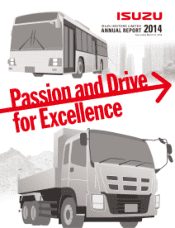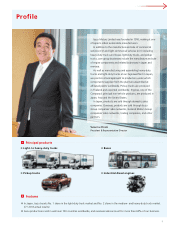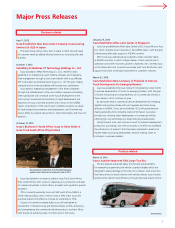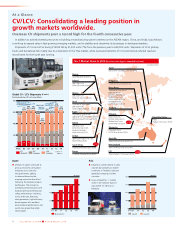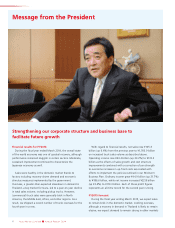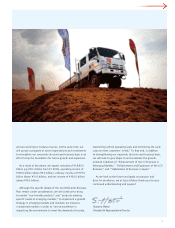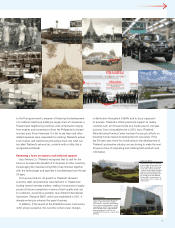Isuzu 2014 Annual Report Download - page 11
Download and view the complete annual report
Please find page 11 of the 2014 Isuzu annual report below. You can navigate through the pages in the report by either clicking on the pages listed below, or by using the keyword search tool below to find specific information within the annual report.
9
At the time of the plant’s foundation, the water
tower in the center was the symbol of Isuzu. It was
designed to evoke a similar water tower at the
company’s Fujisawa Plant, which still stands today.
Dedication of the new Gateway Plant (2012)
to the Thai government’s program of fostering the development
of a national industry by building a supply chain of companies in
Thailand and neighboring countries, with components ranging
from engines and transmissions (from the Philippines) to forged
and cast parts (from Indonesia). It is fair to say these and other
related measures were responsible for creating Thailand’s pickup
truck market, and transforming the pickup truck into what can
be called Thailand’s national car, a vehicle with a utility that is
recognized worldwide.
Renewing a focus on exports and technical support
Isuzu Motors Co. (Thailand) recognizes that its task for the
future is to expand the breadth of its business to other countries,
by leveraging the manufacturing DNA it has inherited together
with the technologies and expertise it has developed over the last
50 years.
First up are products. As growth in Thailand’s domestic
economy stalls, all automotive manufacturers in Thailand are
looking toward overseas markets, making it important to supply
products that are competitive in terms of both quality and cost
to customers, as quickly as possible. Isuzu Motors International
Operations (Thailand) (IMIT), which was established in 2011, is
already working to enhance the export business.
In addition, if the launch of the ASEAN Economic Community
(AEC) proves successful, this new bloc is like to spur changes
in distribution throughout ASEAN, and to Isuzu’s approach
to business. Thailand is offering technical support to nearby
countries such as China and India as a model case for overseas
business. Since its establishment in 2013, Isuzu (Thailand)
Manufacturing Training Center has been focusing its efforts on
boosting human resources development to new levels. If the
last 50 years was a time for contributing to the development of
Thailand’s automotive industry, we are striving to make the next
50 years a time of originating and initiating both products and
information.
At the time of the plant’s foundation, the water
tower in the center was the symbol of Isuzu. It was
designed to evoke a similar water tower at the
company’s Fujisawa Plant, which still stands today.
Gateway Plant
Completed in 1996, the Gateway
Plant includes chassis, paint, and
final assembly plants for pickup
trucks and commercial vehicles,
as well as final inspection, vehicle
evaluation and testing facilities.
New manufacturing equipment
for pickup trucks was added in
October 2012, marking the site’s
transformation into a large-scale
vehicle plant.
Samrong Plant
The history of Isuzu vehicle production
began in 1963 at the Samrong Plant.
The complex consisted of five buildings:
chassis, paint, and frame plants; a final
assembly plant with the final assembly
line for pickup trucks; and a UA plant
where pickup trucks and PPVs are
assembled. There was also a head office
building.

